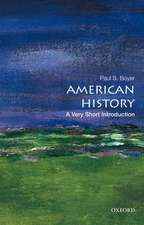Independence Hall in American Memory
Autor Charlene Miresen Limba Engleză Paperback – 10 dec 2013
Preț: 246.37 lei
Nou
Puncte Express: 370
Preț estimativ în valută:
47.14€ • 49.22$ • 39.02£
47.14€ • 49.22$ • 39.02£
Carte disponibilă
Livrare economică 15-29 martie
Preluare comenzi: 021 569.72.76
Specificații
ISBN-13: 9780812222821
ISBN-10: 0812222822
Pagini: 368
Dimensiuni: 196 x 233 x 25 mm
Greutate: 0.52 kg
Editura: MT – University of Pennsylvania Press
ISBN-10: 0812222822
Pagini: 368
Dimensiuni: 196 x 233 x 25 mm
Greutate: 0.52 kg
Editura: MT – University of Pennsylvania Press
Notă biografică
Recenzii
"A book that shows us why history matters."-The Historian "Mires cuts a broad swath through the centuries. We see the forces of preservation and politics converge and collide, countered by the environmental dynamic of a changing urban neighborhood. We also observe how African Americans, always a vital presence in Philadelphia, took liberty's message to heart... Mires's plea for understanding the public memory that historic structures shape should inspire others to follow her lead."-Journal of American History "A fascinating portrait that illuminates the connection between collective memory and history, investigates how traditions and heritage emerge and change, and examines how a heterogeneous society constructs and preserves its history. The book reveals Independence Hall, the most revered symbol of the American republic, as a place of contradiction, where the nation's ideals have been both defined and contested, expanded and limited."-Pennsylvania Heritage "Mires's book frees us from any one-dimensional view of the past, and of ourselves, by showing that Independence Hall, like America, always has been and must be a work in progress."-Philadelphia Inquirer "An outstanding contribution to the study of memory places in the U.S."-Choice "This is a book I have long awaited, one that tells the life of a single building so as to illuminate American history from almost every angle-cultural, social, and political."-Mary Ryan, author of Civic Wars: Democracy and Public Life in the American City During the Nineteenth Century
Cuprins
Contents Introduction 1. Landmark: A British Home for the American Revolution 2. Workshop: Building a Nation 3. Relic: Survival in the City 4. Shrine: Slavery, Nativism, and the Forgotten History of the Nineteenth Century 5. Legacy: Staking Claims to the Past Through Preservation 6. Place and Symbol: The Liberty Bell Ascendant 7. Treasure: Eighteenth-Century Building, Twentieth Century City 8. Anchor: A Secure Past for Cold War America 9. Prism: Redefining Independence for a Third Century 10. Memory: The Truths We Hold To Be Self-Evident





